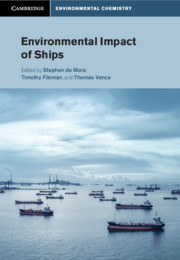Book contents
- Environmental Impact of Ships
- Cambridge Environmental Chemistry Series
- Environmental Impact of Ships
- Copyright page
- Contents
- Contributors
- Preface
- 1 Shipping, Ships and the Environment
- 2 Atmospheric Emissions from Ships
- 3 Oil Pollution from Operations and Shipwrecks
- 4 Waste and Sewage
- 5 Ballast Water
- 6 Biocides from Marine Coatings
- 7 Invasive Species
- 8 Physical Effects of Ships on the Environment
- 9 Ship Noise
- 10 Vessel Strikes and North Atlantic Right Whales
- 11 Nuclear-Powered Vessels
- 12 Environmental Impacts of Shipbreaking
- 13 International Legislative Framework
- 14 Shipping Industry’s Perspective
- 15 Environmental Impacts of Shipping
- Index
- References
2 - Atmospheric Emissions from Ships
Published online by Cambridge University Press: 22 January 2021
- Environmental Impact of Ships
- Cambridge Environmental Chemistry Series
- Environmental Impact of Ships
- Copyright page
- Contents
- Contributors
- Preface
- 1 Shipping, Ships and the Environment
- 2 Atmospheric Emissions from Ships
- 3 Oil Pollution from Operations and Shipwrecks
- 4 Waste and Sewage
- 5 Ballast Water
- 6 Biocides from Marine Coatings
- 7 Invasive Species
- 8 Physical Effects of Ships on the Environment
- 9 Ship Noise
- 10 Vessel Strikes and North Atlantic Right Whales
- 11 Nuclear-Powered Vessels
- 12 Environmental Impacts of Shipbreaking
- 13 International Legislative Framework
- 14 Shipping Industry’s Perspective
- 15 Environmental Impacts of Shipping
- Index
- References
Summary
Atmospheric emissions from ships have not been subject to the same regulations as those on land until very recently. Carbon emissions from the shipping industry are low (per tonne of transported goods) relative to other areas of the transport sector, namely road traffic and aviation. Regulatory controls of atmospheric pollutants such as sulfur dioxide (SO2), nitrogen oxides (NOx) and particulate matter (PM) were imposed on land-based anthropogenic emissions, but not applied to ships.
- Type
- Chapter
- Information
- Environmental Impact of Ships , pp. 11 - 55Publisher: Cambridge University PressPrint publication year: 2020



